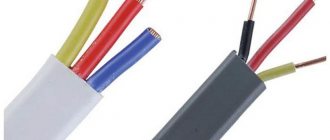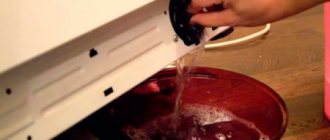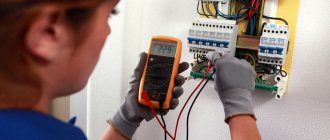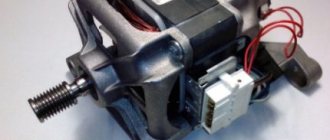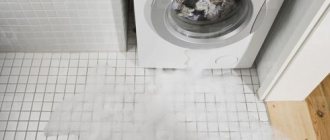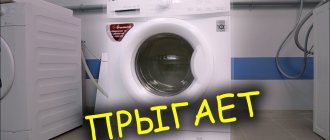When you select the operating mode of the washing machine and press the start button, a situation may arise when the machine draws water, but the drum does not spin. Also, this problem sometimes arises already during the washing process.
To resolve the issue, it is necessary to analyze the situation by conducting accessible diagnostics. In some cases, you can even get your washing machine working on your own - without a technician.
Why the drum in the Indesit washing machine does not spin, we will tell you how to fix the problem in the article.
Why do problems occur?
If the washing machine drum does not rotate, turn off the machine. To do this you need to do the following:
- Remove the plug from the socket. This is necessary to de-energize the washing machine.
- Forcefully drain the water. This must be done using a drain filter located at the bottom of the front side of the machine.
- Open the hatch door and remove the laundry from the drum.
Common reasons for drum failure include the following:
- rotation jammed due to a foreign object;
- drum pulley failure;
- problem with the drive belt;
- engine breakdown;
- drum overload;
- abrasion of graphite brushes;
- failure in the control module.
In addition to the situation where the drum completely stops, unstable operation is possible when the rotation occurs jerkily or with pauses. This is also a reason to carry out diagnostics, identify and fix the breakdown.
Troubleshooting Drum Stopping Problems
First, you should check whether the stoppage of the equipment is not a consequence of a violation of the operating rules. After de-energizing the SMA, you need to wait a while until the hatch opens, then check the laundry in the drum. Maybe there is too much of it or it has clumped up, creating an imbalance. Only after this should you begin to diagnose and identify other possible faults. The information error code that appears on the display will tell you what to do.
By removing some of the laundry and distributing it evenly throughout the drum, you can eliminate the most common reason for it stopping
The drive belt has become loose, fallen off, or broken.
If you hear that the electric motor is humming, but the drum does not rotate, it is worth checking the condition of the drive belt. To do this, remove the back cover of the SM case by unscrewing the fasteners. In some models, you will also have to remove the top cover to do this. Then carefully inspect the position and condition of the belt. If it is cracked, it needs to be replaced with a new one.
The drive belt is easy to install yourself at home
A loose belt is very easy to fix. First, it is put on a small pulley of the electric motor, and then, turning the drum, on a large pulley located above. The main thing is that the belt does not get twisted.
After watching this video, readers will learn how to put a fallen belt on the pulleys:
Electric motor is faulty
You turned on the machine, selected and started the washing program, but the sound of the motor is not heard and the drum stands still. What could be the reason? There are several options:
- brush wear or breakage in one of the motor windings;
- the contact between the control triac in the control unit and the engine is broken;
- The triac that supplies power to the electric motor has burned out;
- The controller processor is faulty or there is a failure in the non-volatile memory.
It is better to entrust the diagnosis and repair of such breakdowns to an experienced specialist. If it turns out that the motor does not work due to wear on the brushes, if you have certain skills, you can replace them yourself.
The author of the video shares his experience in replacing worn-out electric motor brushes in LG, Ariston, Bosch, Indesit, Beko, Ardo and other brands:
A foreign object has gotten between the tank and the drum
This defect is easy to determine: when the drum rotates, a rustling, crackling or other similar sound is heard. There are situations when the drum rotates poorly or completely jams. In this case, turn off the washing machine, drain the water from the tank, empty the drum of the laundry and carefully inspect it from the inside, illuminating the surface with a flashlight.
A bra wire stuck between the tank and the drum and piercing the tank
If a simple inspection fails to detect the object, you will have to remove the electric heater. To do this, follow these steps:
- Unscrew the mounting screws and remove the back cover of the SMA.
- Disconnect all wires going to the heating element, which is located at the bottom of the tank.
- Unscrew the fastening nut on the heater panel.
- Use a flat screwdriver to pry up the heating element panel and carefully remove the heater from its seat.
- Use a flashlight to illuminate the vacated opening and use narrow pliers to pull out the object.
- If nothing is found, carefully turn the drum until the object appears in the opening.
In top-loading washing machines, the tub may become jammed due to curtains that suddenly open. This can happen if the curtains are poorly secured, for example, if a piece of laundry gets caught in the latch.
Latch and curtains in the drum of a top-loading washing machine
Such an oversight can be costly for the owner of the SM - serious damage to the tank, drum and body of the machine is possible.
The drum rotates poorly due to worn bearings
This malfunction is one of the most unpleasant for SMA owners. If the drum does not spin due to the bearings, the repair of the washing machine will have to be entrusted to a qualified technician. To replace the bearings and seal, you will have to completely disassemble the unit. In addition, knocking out damaged bearings and pressing in new ones requires special tools and skills.
Bearing on the drum axis in a washing machine
As you can see, if the drum in the washing machine does not spin, most of the causes of the malfunction can be eliminated yourself, without resorting to the services of specialists. This will save you both money and time.
Diagnosis of failure and its elimination
After stopping work, it is advisable to determine at what stage of the wash the failure occurred. The underwear itself can help with this.
The following options are possible:
- If the items are not soapy, but simply wet, but the drum has stopped rotating, most likely during the spin phase.
- If the items are soapy and in detergent, then the problem arose at the start of work or during the first stage of washing.
It is also necessary to pay attention to whether the machine made uncharacteristic sounds during operation - creaking, grinding, etc. To accurately determine what caused the breakdown, it is necessary to examine sequentially all the nodes involved in the process.
Foreign object
Foreign objects that have fallen into the drum from clothes - the contents of pockets, torn buttons, underwires from a bra, etc. - can cause a malfunction of the washing machine.
As a rule, with such a breakdown, the washing machine makes extraneous sounds - grinding, scratching or tapping - before the drum stops rotating.
Sometimes the stuck item sticks out inside the drum and can be carefully pulled out . But if a foreign object is between the drum and the tank, you will have to partially disassemble the machine to get to it.
To do this, you need to remove the heating element of the machine, the heating element, and, using a flashlight, examine the free space. After the “culprit of the failure” has been found, it is carefully removed using a wire loop.
Work to remove a foreign object must be carried out as carefully as possible so as not to damage the parts of the washing machine.
Tank overload
Any washing machine is designed to load items of a certain weight . This information allows you to control the process of storing laundry and prevent overload.
Exceeding the permissible value can lead not only to a stop in work, but also to provoke rapid wear of components that will bear a load not intended by the manufacturer. If the drum does not spin due to the fact that things are stuffed to capacity, some of the laundry should be removed.
If you have doubts about how many things to put in the drum, then it is better not to add a little than to overload the device.
Bearing jam
The support bearings, of which there may be one or two, wear out during operation of the washing machine. If the wear of parts is significant, the seals begin to leak water. This leads to corrosive processes.
As a result, the rusted bearing does not perform its functions, and its jamming causes the drum to stop rotating.
The solution to the problem is repair and replacement of the worn part. To perform this type of work, appropriate experience is required, so the repair should be entrusted to a professional.
Engine failure
One of the following factors can lead to motor failure:
- short circuit;
- physical wear of brushes;
- winding break;
- contact break.
All of the above reasons for the failure make the washing machine impossible to operate. When the turns on the electric motor winding are shorted, the washing machine is unable to operate under load. In this case, the engine may hum, but the drum will not move.
A violation in the contact circuit, including a break, leads to a stop in the engine. Most often, repairs require dismantling the electric motor . Based on the results of the inspection, the technician makes a decision to repair or completely replace the part.
Another possible breakdown associated with the electric motor is wear of the brushes. This problem can arise during long-term use. The material of the carbon brushes wears off over time, and the part ceases to perform its functions. The malfunction is eliminated by replacement.
Electric motor breakdowns occur less frequently than other operational disruptions.
Drive belt slipping or breaking
The drive belt is designed in the design of the washing machine to transmit rotation from the electric motor directly to the drum. During operation, the belt may slip out of the grooves or break.
This type of breakdown is indicated when the drum can be freely rotated by hand, but the motor is still humming.
In the case when the belt simply jumped off, it is returned to the pulley. This repair can be done from the rear wall. If the belt breaks, it is not repaired, but replaced with a new one.
In a situation where a problem with a belt occurs not for the first time, you should pay attention to the following points:
- Does the belt match the washing machine model?
- Is the belt worn correctly?
- Are there any flaws on the pulley?
When installing the part, it is important to monitor the correct location of the grooves on the pulley and belt.
Control module failure
The control module is an element that is responsible for transmitting commands to nodes. Malfunctions in its operation are eliminated by specialists after high-quality diagnostics using special equipment.
A module failure may be due to one of the following reasons:
- installation of low-quality elements;
- failure situations as a result of voltage surges;
- violation of contacts;
- natural wear and tear of circuit elements.
If the failure is a one-time situation caused by a random combination of circumstances, then you can try to reset the settings. But if work has not been restored, you will need the help of a specialist.
DIY repair
If the washing machine drum does not spin during washing, you can try to fix it yourself. However, devices from different manufacturers differ from each other in some design features and technologies used. Therefore, the repair sequence depends on the model of the washing machine.
Indesit
Let's look at an example of repair using the horizontal loading model WIXL83. If the drum does not spin when the Indesit washing machine is turned on, you should immediately check the belt drive and motor. To repair, the washing machine is unplugged, turned around and leaned on something so that the back wall is free. Next, unscrew the screws securing the oblong hatch, behind which there is a belt drive and an electric motor.
If the belt is intact, then you need to check the motor brushes. Power may not be supplied due to worn brushes or a dirty commutator. The electric motor is secured with two bolts; before unscrewing them, the block with wires is first disconnected. After removal, you can check the length of the brushes and the condition of the commutator. The latter, if necessary, is cleaned to a metallic shine. Short brushes are replaced with new ones.
Samsung
Possible reasons for the drum stopping on a Samsung washing machine are similar to other models. When replacing brushes, you need to make sure that they move freely in the brush holders. Sometimes, due to accumulated contaminants, the forces of the springs are not enough, and the contact is broken. When the electric motor operates, coal dust gets into the gaps and the brushes jam. The problem is solved by removing the brush holders and cleaning the holes.
Another reason for stopping the electric motor is a breakdown of the tachometer located on the rotor. It records the engine speed and transmits information to the electronic control unit. In appearance, the knot looks like a small metal ring, sometimes covered with a plastic casing. There are 2 small diameter wires coming from it.
The tachometer is checked with a multimeter (tester) in ringing mode. The wires are connected to the device and the rotor of the electric motor is rotated by hand. If the sensor is working properly, the multimeter will make short sounds (the needle oscillates). Otherwise, replacement will be required.
LG
In an LG washing machine equipped with a direct drive from an inverter motor, the drum does not spin or jerks slightly due to a broken Hall sensor. When you try to turn it on, a whistling sound is made.
To access the engine, you need to disconnect the unit from the mains and remove the back cover, which is held on by four self-tapping screws. Next, unscrew the central engine bolt. To do this, you will have to fix the rotor. A screwdriver is inserted obliquely into the upper vertical slot of the protective disk and pressed against the head of the hidden bolt. Then unscrew the 6 fasteners of the disk with coils and remove it.
On the back side of the removed element there is a Hall sensor. It is fixed with plastic latches, and the connector is disconnected before dismantling. Use a knife or flat screwdriver to pry up the fasteners and the sensor is easily released. Having replaced the damaged element, everything is assembled in the reverse order.
Bosch
When the drum stops in the Bosch Maxx 5 washing machine, error F21 appears on the display. The machine does not carry out the program and does not fill with water. First, after disconnecting from the network, you need to check with your hand the free rotation of the drum. If everything is in order, inspect the belt drive. Access is via the rear hatch.
If the belt is intact, you need to remove and check the electric motor. To do this, perform the following steps:
- remove the belt;
- place the machine on its right side;
- remove the bottom cover (you will need a T20 sprocket);
- disconnect the block with wires from the engine;
- unscrew the 2 mounting bolts;
- remove the engine.
The tachometer is checked by ringing with a multimeter. If it is in good working order, you need to remove the brushes and replace them if necessary. The sequence of disassembly and assembly of the Bosch Max 4 and some other models in this series is similar.
Beko
The main reason the Beko washing machine drum stops is wear on the brushes of the commutator motor. When turned on, the machine draws water, and then stops showing signs of life. The algorithm of actions for replacing them is standard, but there are some features. Access to the engine is through the rear hatch. By unscrewing the screws and removing it, you can inspect the internal mechanism.
Before removing the engine, you need to release the transmission belt and disconnect the block with wires. The electric motor housing is secured with two bolts with heads that have sprocket cutouts; to unscrew them you will need a T40 socket.
The brushes are inserted into special holders, which are secured to the motor housing with screws.
After replacing the worn elements, everything is reassembled in the reverse order.
Zanussi
Replacing brushes in a Zanussi washing machine is not difficult. But you won’t be able to get to the engine through the rear wall. To implement your plan, you need to place the machine on the floor face up. From below there is access to the motor. It is not necessary to remove it. The brush holders are fixed with self-tapping screws; they are removed after first unscrewing their fasteners and disconnecting the connectors.
The lack of contacts may be due to wear, jamming of the brushes in the guides, or contamination of the armature with coal dust or burning. All causes must be checked and eliminated. The plastic brush holder is disassembled into two halves and the metal guides and brush are removed from there. If you don’t have the part you need for this particular model, you can look for a replacement. It is enough to select brushes of suitable sizes from other units, you just have to solder the wires.
Electrolux
The Electrolux dryer also has a drum, which due to malfunctions one day refuses to spin. The main reason for this problem is wear of the support rollers on the engine or housing. The problem is solved by replacing them. To access the internal mechanisms, remove the side walls and top.
The engine is not removed, but only the tension spring on it is unhooked with pliers. After this, the entire assembly can rotate freely. Next, the old video is removed and a new one is installed in its place. The compressor housing interferes with these manipulations, so it will have to be tilted slightly. Before installation, the shaft is lubricated. Then I set the belt straight and put it on the engine. The drum is rolled by hand several times to obtain the parts of the working position. At the end, fix the tension spring and secure the side walls.
"Ariston"
In addition to the listed reasons for the drum not rotating in washing machines, there are unusual cases. One of them is broken wires. This sometimes happens after inattentive self-repair after removing the engine or drum.
In the Ariston washing machine, the electronic unit is located on the rear wall at the bottom left. The blocks with wires are connected from the inside and directed inward. When performing any manipulations or moving large components, an unintentional impact on these elements is possible. As a result, the pads are crushed or the wires are torn off. Moreover, the gap may not be visible, but there is no contact.
Therefore, before repairing the electronic unit, you should carefully check the integrity of the connections with the device; perhaps the malfunction occurred due to missing contacts. Please note that the connecting blocks are made of thin plastic and disassembly must be done carefully.
"Ardo"
A malfunction occurs when a full drum tries to turn during washing, but cannot, spinning does not occur. It feels like there is not enough power. This is typical for washing machines with asynchronous motors, such as Ardo. Power loss occurs due to a decrease in the capacity of the starting capacitor.
If you open the back wall of the Ardo washing machine, the part you are looking for can be found at the top right above the drum. Using a 12 mm socket, unscrew the fixing nut and remove the capacitor. The failed part must be replaced with a similar one. Ardo has a 16 mF capacitor. If you install an element with a larger capacity, the engine will overheat, if you install a smaller one, the power will be lost.
Calling a master: where to find and how much to pay?
It is not in all cases possible to repair a washing machine yourself. If you do not have special knowledge and tools, it is advisable to contact a repair service .
You can find such a company on the Internet. There you can read reviews of the work of the masters and study the price list.
The cost of calling a technician is determined by the complexity of the breakdown, the need to use additional equipment for diagnostics, replacement of parts and assemblies. The price of services may differ by region and fluctuate even within the same city, as it is determined by the pricing policy of the company.
Average cost of work in the capital:
- belt replacement – from 900 rubles;
- replacement of motor brushes – from 1,400 rubles;
- broken wiring – from 1,500 rubles;
- replacement of bearings - from 3,300 rubles, etc.
If replacement parts are required, their cost will be paid separately by the customer.
The price also increases if, along with eliminating the breakdown, it is necessary to carry out preventive maintenance of other components or replace worn parts, the unsatisfactory condition of which became noticeable after disassembling the washing machine.
Companies that operate officially must provide a guarantee for the work carried out by the master.
What to do to prevent breakdowns?
In order for the Indesit washing machine to serve for a long time, and a situation in which the drum does not spin does not arise, you should take into account the following recommendations:
Even at the stage of putting laundry into the drum, you should control that foreign objects do not fall into it - go through things, check pockets, sew on loose buttons, etc.- If the washing machine begins to make unusual sounds during washing - grinding, tapping, etc., its operation must be stopped immediately, even if the drum has not stopped and continues to spin.
- Zippers must be fastened on items before washing.
- Unstable operation of the device is a reason to understand the causes of the failure and eliminate them in a timely manner, before serious breakdowns occur.
- The washing machine requires careful handling. Do not place containers with liquid on top of it, which could spill and damage the control module located at the top of the device.
- Detergents chosen for washing should be intended for automatic machines - they do not form excessive foam and do not pose a threat to the mechanisms.
Periodic inspection of your washing machine will help it work longer without breakdowns.
Started and stopped
The laundry is loaded, the program is turned on, but the work does not start, the drum does not rotate. Or he still does a favor and makes a couple of lazy turns, but in the end it all ends very quickly with an elementary stop of a capricious part. If your washing machine has a display, it will display an error code and nothing can be done about it. This happens for a number of reasons:
- the laundry is poorly distributed in the drum, causing an imbalance;
- the drive belt fails;
- there are problems with the heating element;
- problems appear with the engine (brush wear);
- a malfunction of the tachometer (a special element that regulates the rotation of the motor) occurs;
- a breakdown of the electronic module “pops up”;
- there are problems with the power supply wiring;
- there is a foreign object in the tank.
There is a feeling that with such an extensive list of reasons, it is incredibly difficult to understand what exactly is broken, but this is not the time to panic. Nothing bad will happen to technology if you calm down and approach the problem intelligently.

